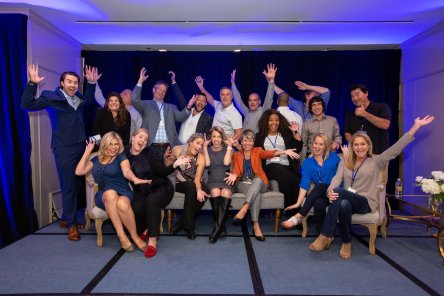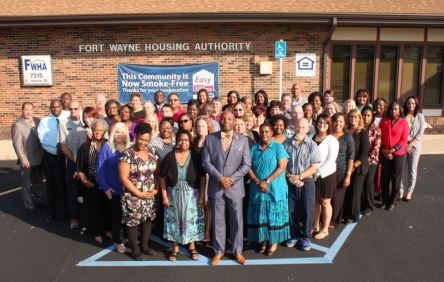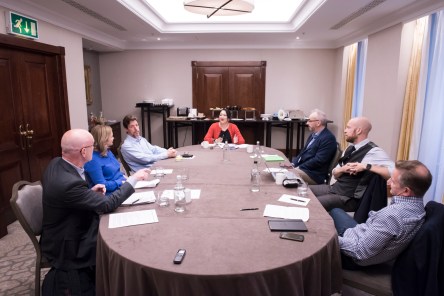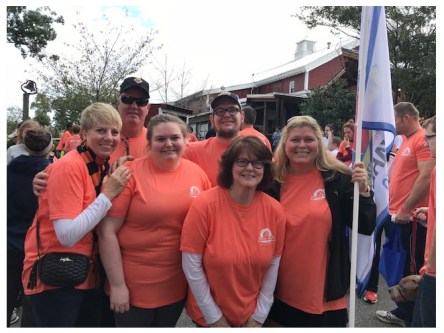Choosing the right property management software determines the efficiency and productivity of your organization. Jumpstart your selection process with these eight simple questions. Is the software installed at the premises or cloud-based?This is a matter of preference. Some organizations prefer installed software because data access does not depend upon an internet connection. The industry, however, shifts towards cloud-based platforms. Such web-based software permits users to access the data in the office, in the field and anywhere in between. Cloud-based solutions often include updates for the latest improvements and changes in compliance. Staff is free to focus on their roles, not the nuances of software. What security and backup procedures are available? Cloud security services combine convenience with safety. Ensure that your cloud-based software offers data recovery, encryption and around-the-clock server operation monitoring. Is the pricing model determined by the number of users or units? Software may be priced per licensed user or per unit. Licensing by user may be convenient for organizations with few employees and limited plans for growth. Pricing by unit allows the greatest flexibility and scalability. Staff growth and software usage are not hampered by paid licenses. Is the product out-of-the-box or customizable? Turnkey solutions offer the ability the hit the ground running. Customizable systems will suite your portfolio more precisely and grow with you as your needs change. Does the software integrate with other services necessary for your business? A fully integrated platform makes daily operations easier. The suite keeps data consistent between services such as accounting, leasing, resident screening, marketing, maintenance, and utility billing. When is technical support available? Emergencies don’t wait for convenient office hours. Check support service hours to ensure that you can receive assistance on weekdays as well as weekends. Read...
The Excel Exodus
New wave of tracking tools
When it comes to Excel, there are two kinds of users: those who love it, and those who love to hate it. Regardless of which camp you’re in, there’s no denying the ubiquitous tracking tool has earned its role as a mainstay in offices in every industry across he world. But as the complexities of business have grown, so has the need for flexible tracking tools—a fact that’s increasingly obvious in senior living. With many different levels of care, various floor plans, myriad amenities and portfolios of communities, new time-saving tools can have a huge impact. In this post, we’ll examine common budgeting and tracking challenges faced by senior living operators and a solution that makes all the difference. The challenges: Antiquated systems are inefficient Since most companies purchase office software packages, it seems most cost efficient to use the spreadsheet that’s included to record and analyze the organization’s budgets. And while that strategy is an effective way to save money on paper, creating a scalable document to track all business operations from a blank tab in Excel is incredibly painstaking and time consuming—and once it’s been created, maintaining the document is no easy feat. If you recall the concept of opportunity costs from freshman economics, you’ll begin to understand that there is no efficiency in sapping countless man hours to make a tool not created for your business actually work for your business. Versions get outdated quickly—and aren’t easily shared Have you ever wasted time updating a spreadsheet only to find that you weren’t looking at the latest version? One of the most common frustrations with using static spreadsheets, rather than live solutions which are updated in real time, is the data becomes stale quickly, especially when multiple teams are making edits. On...
YMF New Orleans
3 Quick Takeaways
The Yardi Marketing Forum took New Orleans by storm earlier this month. This sold-out event drew top multifamily property marketers from across the country to The Big Easy for three days of fun, education and networking. View the photo album for a behind-the-scenes look. Attendees enjoyed focused attention from Yardi team members and exclusive guest speaker presentations. Google’s session on “The Age of Assistance” gave the audience three tips for winning in today’s competitive search environment: be there, be quick and be useful. Keep reading to see how you can apply these marketing takeaways from the forum to your property management business today. Be There You can’t win clicks if your customers can’t find you. Ben Waltzer from Google Fiber shared that today’s consumers are “more curious, more demanding and more impatient than ever before.” In fact, 15% of Google searches today are ones they’ve never seen before. Co-presenter Jeff Kirschenmann asserted that searchers “expect us to deliver relevant results at the right time.” Do you have a plan in place convert prospects by connecting during moments of intent? A successful marketing strategy includes being present at every stage of the customer journey. This might include SEO for long tail searches, paid ads for different demographics and nudge marketing that spurs website wafflers into action, as well as a healthy presence on review sites and social media platforms. If that sounds like a lot and you just don’t have the time or staff to handle it all, you might want to consider the advanced property marketing services of RENTCafé Reach. Be Quick Filmmaker Gavin Garrison’s talk focused on the emotional impact of storytelling – not just for video but for all forms of marketing. He spoke about using the power of relatable emotion to...
Multifamily Update
From Yardi Matrix
Jeff Adler, vice president of Yardi Matrix, assisted by Jack Kern, director of research and publications, recently delivered a webinar on the state of the multifamily industry. Excerpts follow. Q: How is the U.S. economy overall? A: It’s in good shape. Gross domestic product and employment are steady, wages are rising and the labor market is tight. Inflation is rising but under control. Q: And the multifamily market? A: It’s good too, although there are a few crosswinds. Jobs and population growth are strong but shifting to lower-cost cities, and homeownership is gradually rising. Multifamily capital is abundant, and new supply deliveries are weighing down on several markets, with the level of new supply flattening but not declining. Q: Has multifamily supply leveled out, and why? A: Construction delays and financing are a factor. Construction is just catching up to household formation, and builders are focusing on higher-price single family homes. Q: What are some policy changes addressing affordability? A: There are some proposed and implemented government mandates. Other market-oriented changes include a community in Kissimmee, Fla., that encourages residents to cover some of their rent by sharing their apartment on Airbnb; “rent by bedroom” communities that combine private bedrooms with shared kitchen and living areas. The coworking trend offers a model for coliving. Societal infrastructure, especially education, is the power of local economy, which drives multifamily investment. Q: What job growth trends are affecting multifamily? A: Companies are relocating and expanding in lower-cost markets—places like Phoenix, Orlando, Fla., Houston, Las Vegas and Raleigh, N.C. Tech hubs are emerging both in formerly non-tech metros and traditionally overlooked cities, such as Indianapolis, Pittsburgh and Philadelphia. Q: What are some of the other factors in play? A: The 2017 tax reform that caps the deduction for...
Self Storage Update
From Yardi Matrix
The self storage industry has been strong over the last several years, with economic growth creating new households and driving demand. Can this pace continue or will the recent supply surge outpace demand? That question formed the basis of a recent web presentation by Jeff Adler and David Dent, vice president and senior real estate market analyst, respectively, for Yardi Matrix. Their discussion focused on four areas: Macroeconomic Outlook The U.S. economy is in very good shape, Adler and Dent reported, with gross domestic product growing, inflation under control, and a tight labor market “pulling people off the sidelines,” although trade and immigration policies could brake the growth. Their research reveals that millennials and Baby Boomers are leaving big cities such as New York, Los Angeles, Chicago and Miami in favor of smaller, lower-cost cities with concentrations of intellectual capital work, which in turn drives storage demand. Destination metros include Dallas-Fort Worth, Tampa, Fla., Atlanta and Charlotte, N.C., along with retirement favorites such as Las Vegas and smaller mountain metros in the Appalachians and the Rockies. However, rental market fundamentals are faltering, with only 12 of 133 markets studied by Yardi Matrix showing year-over-year rent increases in September 2018, versus as many as 41 in previous years. Profile of Current Supply and Demand Domestic migration patterns have made Las Vegas, Tampa, Phoenix, Orlando. Fla., and Columbus, Ohio, the most attractive metros for self storage providers, Adler and Dent reported. The national average of self storage projects under construction and planned as a percent of existing inventory is 9.5%. Portland, Ore., Nashville, Tenn., Orlando, Boston and Seattle have the highest percentages. Approximately half of storage customers are in the process of moving while the other half are long-term users. Adler and Dent noted that approximately...
Doing More
YARDI, SPRINT & CBRE
“Do more with less”—a philosophy that some fear is a recipe for exhausting people and systems. But a recent webinar sponsored by the Professional Retail Store Maintenance Assn. (PRSM) showed how the right technology, when properly executed, can benefit workers and businesses—and cut operational costs by tens of millions of dollars. The webinar shared best practices for choosing and implementing technology, as well as improving internal processes to make global management work. Commercial real estate services and investment firm CBRE, which manages communications services provider Sprint Nextel’s real estate operations, including its building automation systems, highlighted its energy journey and the implementation of Yardi Pulse Central Control, former Proliphix, in more than 1,200 U.S. retail outlets operated by Sprint. Chris Gardner Cole Schooland Ken Cooper After taking over Sprint’s real estate operations in 2009, CBRE used technology and improved processes to lower Sprint’s operating systems costs by $35 million, generate more than $750,000 in energy savings, reduce energy costs by 14%, and cut the company’s small box retail division’s maintenance costs by 15-20%, Chris Gardner, real estate manager for Sprint Nextel, told the webinar participants. A CBRE audit revealed more than 2 million hours of unnecessary run-time. Dedicated to investing in long-term solutions, CBRE greatly expanded its use of Yardi Pulse Central Control to optimize building lighting and control heating, ventilation and air conditioning (HVAC) systems with cloud-based remote management software. The solution enables easy scheduling adjustments and safeguards for continuously monitoring temperatures, thermostat settings and potential equipment malfunctions, ensuring each building only uses the energy it needs. But investing in the right solution meant taking the conversation far beyond mere energy savings to address maintenance costs, asset health, employee efficiency and even revenue. According to webinar participant Cole Schoolland, this requires a multifaceted...
Resident Stories
Focus on person-centered care
For many caregivers in senior living communities, residents’ identities are synonymous with their ailments. They begin to embody the treatments and assistance they require each day. While residents are much more than a name on a chart, the rich stories of their former lives often go untold. Moving into a new community can feel like letting go of one’s old self, and if a resident is struggling with dementia or cognitive disorders, the sense of loss is even greater. Recognizing the importance of deep personal understanding, many caregivers and communities have embarked on a mission to uncover residents’ stories. Truly knowing a resident and honoring their individuality has been proven to have medical benefits and improve their quality of care. In the senior living industry, it’s called person-centered care (PCC). The concept itself is not new—it’s been studied since the late 1980s—but, thanks in large part to the Affordable Healthcare Act of 2010 which emphasized the need for change from a traditional clinical care approach to a more personal one, the movement has gained momentum. Person-centered care has no official definition, but its supporters generally agree that what distinguishes PCC from the traditional model of care, which views the patient as a passive receiver of treatment, is a commitment to patients actively participating in their own medical plan. Other fundamentals of PCC include viewing treatment as an on-going process, one that nurtures and empowers the person being treated, enabling elders to experience purpose and meaning in their daily lives. At its core, person-centered care compels caregivers to see residents for the people they are—and not let the need for assistance with daily activities diminish one’s personhood. How can senior living operators and caretakers begin to make the shift from a traditional model of treatment...
Super Support
Fort Wayne Honored by NAHRO
Support services can be more effective and valuable to a community when providers work together. By taking a collective approach to serving needy residents, organizations can identify synergies in services and carefully plan which are best fit for specific clients. For example, a supportive housing program may have a vacant unit reserved for disabled veterans, and a veterans’ service office may have a client graduating from a transitional housing program. Coordinating those programs would help to smoothly transfer the veteran to the permanent housing unit. In Fort Wayne, Indiana, the Housing Authority (FWHA) has stepped up to help local organizations work more cooperatively. For its effort, FWHA received an Award of Excellence from the National Association of Housing and Redevelopment Officials (NAHRO). FWHA assists more than 8,000 individuals in their community at any point in time. Their clients’ needs for assistance go far beyond basic affordable housing subsidies. Some clients are formerly homeless and need assistance furnishing their new permanent homes. Others require access to discounted food and clothing. In fulfilling those types of client requests, FWHA found itself working with many local service providers. There are more than 150 in the Fort Wayne area, each with a set of services available. George Guy, CEO and director of FWHA, saw an opportunity to benefit the community by getting those providers together with a goal of forming a consortium of representatives that could exchange and coordinate services. The result of that coordination effort is what’s become known as Housing Strategies Meetings. FWHA invited 270 individuals to the first session, at which attendees saw more than 35 agencies present a high-level overview of their services. While receiving that program-level information was valuable, personal connections made in the room were also real benefits of the meeting. FWHA...
5 Tips for Client Retention
At Coworking Spaces
Today’s entrepreneurs and remote employees have several workspace options, often including the comfort of their own homes. To attract and maintain clients, transform your coworking space into a unique destination with a welcoming community. Offer Top-Notch Security Clients want their shared workspace to feel safer than their local coffee shop or home office. 7 Tips for Improved Security can help you establish a place where clients, their possessions, and their data are secure. Ensure that your security software is accompanied by human backup. For example, post a phone number that clients can contact if the door access control is ever on the fritz. Such measures will help clients feel supported in an increasingly automated world. Continuing Education Experience-driven spaces are the latest in office design. Continuing education events offer new experiences for clients. The classes also double as a value-added service. You may want to: Host how-to workshops for popular software programs Invite experts to facilitate theme-based seminars, such as marketing and project planning Create member forums where clients can network Seminars on work-life balance techniques and relaxation methods Create Thoughtful Ambiance Thoughtful design pays off. Your design can inspire your clients, enhance the atmosphere, and promote client wellbeing. Each feature defines your space as a desirable and valuable destination. Add indoor plants to help cleanse the air while combatting the sterile office vibe Opt for sustainable office supplies, which are popular with young professionals Mix up your seating with a combination of conference-style tables as well as private nooks Create different work environments with varied lighting in different rooms or regions of the workspace Consider placing white noise machines in conference rooms for privacy Build Community through Experiences Many clients will opt for a shared workspace because of the potential for social interaction. Fulfill their expectations with community-building tools and activities. Consider: Games, both digital and real-world Indoor rock climbing Yoga classes Live music Mini massages and acupuncture Sports tournaments The right activities for your community depend on how your space is divided. Use your best judgement to establish an engaging yet professional atmosphere. For new workspaces, it may be difficult to gauge your clients’ interests. Consider polling members on what activities they’d like to have on site. Satisfy Bellies In addition to coffee, get creative with your treats! Some clients use snacks as a way to take a break. Others will snack when they can’t take a break for a real meal. Save the day by offering a combination of fun, quick, and nourishing treats. Hot cocoa bars with a variety of toppings Cupcake stations add cheer (and a sugar rush) to any slow afternoon Build-your-own trail mix bars are a simple and healthy way to jazz up the snack scene Quick, customizable lunches (think hotdogs and burgers) are an inexpensive and easy way to show client appreciatio Built-in Marketing These suggestions can transform your coworking space into a unique destination with a welcoming community. They come with an additional bonus: free marketing. Fun features create opportunities for clients to post photos on social media. Be sure to have your social media handles posted throughout the office so that they can tag your...
UAE Update
The rise of REITs
The Gulf Cooperation Councill (GCC) has witnessed significant growth in the number of real estate investment trusts (REITs) across the region, with over seven publicly listed REITs established to date. Since 2006, regulations have perm itted REITs in the Dubai International Financial Centre (DIFC), but previous market downturns delayed any real progress within this particular sector of real estate. The first REIT in the United Arab Emirates (UAE) was established in 2010. More recently in the UAE, ENBD REIT and the Emirates REIT were listed on NASDAQ Dubai with market capitalisations of $261 million and $289 million respectively. In other GCC countries, such as Bahrain and Kuwait, there are now private REITs with total sizes of $80 million and $100 million, respectively. The introduction of REITs in Saudi Arabia by the Capital Market Authority (CMA) in 2016 was part of the National Transformation Program (NTP) and Saudi Vision 2030. This included a regulatory framework with a minimum of 100 million Saudi riyals ($26.67 million) capital for REITs, and borrowing not rising above 50 percent of the fund’s total asset value. The market in Saudi Arabia is divided between two REIT investment strategies, the mixed-asset and the specific-asset class approach, with a tendency towards the specialisation of REITs, along with a focus on asset classes that are common to the region, such as office, retail, education, healthcare and logistics. The making of the REIT The goal of the REIT is to provide investors with access to high-grade, low-risk, income-generating real estate assets. About 45 percent of investment professionals in the region see the GCC’s real estate market as mature enough for REITs to surge. Although tax efficiency has less impact on the REITs in the GCC, it offers liquidity and flexibility for investors and real...
UK Think Tank
A Coworking Conversation
The evolution of the flexible office sector has shaken up the real estate industry and has arguably changed it for the better. Yardi recently brought together a panel of experts in the UK to discuss the many segments of flexible offices and what lies in store for the sector. Mary Finnigan, head of transactions, real estate, WeWork Chris Pieroni, operations director, Workspace Group Adrian Goldney, co-founder, Flexible Office Space John Williams, head of marketing, Instant Group Joff Sharpe, head of operations, British Land Tony Freeth, director coworking, Yardi Europe Liz Hamson, editor, Property Week – chair LH: With all the different definitions out there, what should we be calling the sector? Should there be a standard definition or does it really matter? CP: All the definitions out there are very different – hybrid, coworking, flexible, service – and then you’ve got all sorts of issues around whether they are an operator or a landlord and then you’ve got all sorts of issues about what sort of services are offered; whether they are exclusive or not. And it’s really complicated to pull all the data together and try to get an understanding. I’ve got my own view on where we stand in the flexible office market and we didn’t fit into any of the definitions. We’ve decided to just look at the flexible market. LH: So what do you define flexible as? CP: So we had three different categories – something under three months, and then we stopped at over 12 months. But actually, I think now as larger corporates want flexibility, you might be saying flexibility for them is three years. So I don’t know, but we stopped at over 12 months. JS: I don’t think the starting point is flexibility; it’s...
Office Update
From Yardi Matrix
A strong U.S. economy has given rise to an equally robust office real estate market. Office-using employment and wage gains outpace the national average growth rate, according to a recent report from Jeff Adler and Jack Kern, vice president and director of research, respectively, for Yardi Matrix. Their update, presented in a webinar, focused on the macroeconomic outlook, national office fundamentals and trends, and technology disruptors. Employment, gross domestic product, household formation and income levels are in good shape, supporting growth in the office market segment. More than half of the 115 major markets surveyed by Yardi Matrix are experiencing moderate rent growth. Intellectual capital—companies and workers—are leaving high-cost gateway markets such as New York, San Francisco and Los Angeles for lower living and business costs. Job growth is highest in emerging tech hub markets such as Reno, Nev., Boise, Idaho, Nashville, Tenn., and Orlando, Fla. An aging population is fueling growth in the medical office sector, especially in Sun Belt locations. “Most markets remain undersupplied because supply isn’t keeping up with demand,” Adler said. High levels of pre-leasing activities indicates continued strong demand and likely swift absorption of new supply, especially in tech hub market hubs such as Austin, Texas, Raleigh-Durham, N.C., and Orlando. Other pressures on the office market include a decreasing amount of square footage per employee, which is especially pronounced in central business districts and high-cost metros. In addition, coworking is growing, especially in dense, high-cost gateway markets, diverting 1-3% of office demand from traditional office leases. Coworking could eventually represent 10% of available space, Adler said, with Yardi a leader in providing the infrastructure and technology for coworking and shared space environments. Technology trends likely to change the nature of work and create wealth in office real estate include...
Walk for Hope
Yardi Raleigh
The Yardi Raleigh TKO group recently participated in a notable local event to raise awareness and research funds for mental illness: the 30th annual Thad and Alice Eure Walk for Hope. Team members who walked for the cause were Blair Kramer, Sean Bryant, Pam Davison, Karen Gibson, Jim Hill, Mimi Hill, Trevor Hyde, Chuck Justice, Kimberly Wood, Victoria Parsons, Travis Taliaferro and Rich Stevenson. The group raised $2,583 to contribute to the Walk for Hope Foundation. Founded by a well-known Raleigh family after their son was diagnosed bipolar disorder, The Walk for Hope Foundation has awarded 139 scientific research grants totaling more than $5.7 million. These funds have leveraged an additional $145 million from the National Institute of Mental Health (NIH) and other federal agencies. The TKO team’s participation in the walk has a personal and professional connection. “We lost a co-worker to suicide and the office was stunned. No one knew there was a mental health issue. Since that time, we have worked hard to support one another and have found that supporting causes like the Walk for Hope and the Foundation of Hope is a great way to support our community and help reduce the stigma that is unfortunately still attached to mental illness,” explained Kimberly Wood, a P2P Consultant on the team. “We reach out to one another when we sense someone is struggling. The Walk for Hope is a fun event, but it is rooted in very strong memories of Tim Owens, who we still miss to this day.” Learn more about the Walk for Hope Foundation and their year round events to fundraise for mental illness research. Yard is Energized for Good! Learn more about the company’s philanthropic and volunteer efforts around the U.S. and the world...
Coworking Security
7 Ways to Keep Everyone Safe
As the manager of a coworking space, you walk a fine line. Your site must offer security while helping members and guests feel welcome. The following seven tips promote digital and physical security without interrupting ease-of-use. Create a Warm, Automated Welcome Automated attendance trackers deliver convenient yet controlled access to your shared workspace. Combine Kisi and KUBE door access systems to manage member and visitor logs as well as billing details. There is no need to have users register and pay for common use areas in advance. Users pay as they go, minimizing cancellations and billing disputes. As an added convenience, any user with a mobile device can begin working automatically. With access and billing aside, your reception staff can focus on welcoming clients, answering questions, and placemaking. Offer Private Wi-Fi As an alternative to shared wi-fi networks, private networks provide excellent digital security. Each user receives a unique code that doesn’t overlap with fellow users’ access. Consider linking access with membership. A single code issued to all members and guests does not provide the protection you need. Link access codes to users’ unique membership level as an additional layer of security. Have that code expire with the membership or expire after a certain duration of time for guests. Switch Up Guest Access If individualized wi-fi credentials for guests seems tedious, consider a simple guest wi-fi network and password. For added security, update log-ins at least every quarter, if not every month. Encourage Privacy with Filters Install an IP filtering system that can minimize undesirable data sharing and burdensome traffic loads. Not all data theft occurs digitally. Applying privacy screen filters on your in-house computer monitors limits the access of wandering eyes. Benefit from Member Education Education is key to risk mitigation. During new...
5 Tips for Excellence...
In property management
Building your property management business can feel like you’re aiming at a moving target. Changing industry expectations and trends may leave you clamoring for solutions. These five, timeless tips for excellence in property management can help you take your organization to the next level. Offer competitive conveniences for renters. Residents and prospects expect flexibility. Whether they prefer to interact with you online or in person, have systems in place to accommodate them. Enhance your website with online leasing, digital payments, and online maintenance requests. For those who embrace person-to-person interaction, build positive relationships with customer relationship management tools. Improve efficiencies with end-to-end property management software. When you operate efficiently, you can offer stellar services at lower costs without decreasing your profit. Begin with a software suite that automates back office tasks like accounting, reporting and compliance. Achieve efficiency with Yardi Breeze for small and mid-sized properties or Yardi Voyager for larger residential and commercial portfolios. Empower employees through education. The best software is powerless without a team that understands how to use it to its fullest potential. Online learning encourages your team members to learn at their own pace. Staff will also be able to access classes and review as needed, without costly and time-consuming training. Optimize revenue opportunities. There are several ways to boost profits without increasing rent. Some methods will require the property owner’s involvement while others you can pursue alone. Once you’ve explored your options, you can use the improved profitability of one property to pursue similar changes at other properties that you manage. Be proactive about your online reputation. Make it easy for tenants and prospects to get in contact with your team to intercept issues before they appear online. When negative feedback arises, address it promptly. Be sure to...
Culture First
At Bloom Senior Living
Bloom Senior Living has a simple, yet aspirational mission: to help residents flourish. The family-owned and operated company, started in 1963, is dedicated to helping seniors live full, meaningful lives. But just as important as it is to make sure residents feel like family, at Bloom, staff members feel like family too. The leadership team has made creating a nurturing company culture their priority, because they believe if the culture is right, everything else—including delivering on their brand mission—will fall into place. That’s why it’s critically important to Tony Kantor, principal and director of finance, and Brad Dubin, principal, director of acquisition and general counsel, to create an office where employees feel valued and have all the resources they need. With eight communities across five states, Bloom began using Yardi to create a scalable business model that put people first. “We wanted a fully integrated product, one system throughout the entire cycle. It’s more seamless and efficient for our team, who already have to learn lots of different systems. Streamlining is a major benefit,” Dubin explains. It’s that efficiency that’s helped the company’s 40 Yardi users simplify processes and eliminate tasks in order to do what they love most: deliver great customer service to residents. “We use Yardi for everything,” says Dubin, who handles Bloom’s marketing and sales. “As soon as we get a prospect, we enter them in the system and start tracking all their data. All the calls, all the marketing activity. Sales one hundred percent relies on the CRM system. I can’t imagine not having it.” What the team likes most is the structure the software has helped create. Having an automated process takes the guesswork out of the sales cycle and keeps prospects moving through the pipeline. “It’s helped us systemize the...
Online Payments
8 Reasons to Upgrade
Online payment processing is quickly becoming the industry standard. If you’re on the fence about making the switch, here are eight excellent reasons for you to upgrade with confidence. 8 Reasons to Upgrade to Online Payments Gain the competitive advantage. Research by the Association for Finance Professionals reveals that nearly 80 percent of organizations are transitioning to electronic payments. If you’re one of the few businesses not making that transition, you may lose clients to your competitors. Eliminate redundant data entry. Using an online payment system cuts back on data entry and subsequent errors. This is especially true when it integrates with your property management accounting software. After a payment is made, user data automatically populates in the system. Offer flexibility to your residents. Nearly 80 percent of residents prefer to pay rent electronically. With online payments, residents can easily submit payments 24/7 from their desktop or mobile device. Enjoy fewer late payments. By increasing convenience, many users have witnessed a decrease in delinquencies. Mariana Estrada, VP of Operations at Roscoe Properties says, “For the month of May, we collected 95% of payments, on time and electronically, thanks to Payment Processing. That’s massive! That’s money in the bank without any staff intervention.” Lower costs for you and the environment when you go paperless. An article in CFO Magazine explains how electronic payments work out to be 10 times cheaper than paper checks. Among the data, analysts note that the total cost of an ACH transfer is between 25 cents and 60 cents. (The range depends on several factors.) A paper check, however, sets businesses back between $1.25 and $3.00. Decrease the need for storage. Paper record storage becomes a costly battle for square footage. With electronic payments, all of your data is securely stored...
Zeroing In
On Energy Neutral Buildings
It was a different era in 1997, when Portland, Ore.-based New Buildings Institute, a nonprofit organization that promotes energy performance improvements in commercial buildings, was founded. LEED and ENERGY STAR® buildings, Living Buildings, market adoption of renewable energy to any measurable degree—all were yet to come. “Reducing energy use was almost exclusively driven by utility efficiency programs focusing largely on fluorescent lighting upgrades,” NBI reflected recently. Today, At least 50% of customers have the option to purchase renewable electricity directly from their power supplier according to the U.S. Department of Energy. Energy conservation has become considerably more sophisticated in a report NBI recently released to coincide with the organization’s 20th anniversary. While still small in relation to total buildings and floor space, zero building development in the U.S. is accelerating, according to the report. Zero energy buildings—defined by the U.S. Department of Energy as a property or community where “on a source energy basis, the actual annual delivered energy is less than or equal to the on-site renewable exported energy”—are gaining favor across virtually all property types. The recent NBI report, “Getting to Zero Status Update and List of Zero Energy Projects,” highlights nearly 500 zero energy commercial building projects across the U.S. Projects owned by for-profit companies account for 26% of the list. Privately held buildings account for 46% of zero energy buildings, with K-12 schools representing 18%. By contrast, NBI’s first Getting to Zero Status Update in 2012 reported just 60 commercial and multifamily buildings or projects that were either verified as zero energy or approaching that level. Zero energy buildings had the potential to grow in popularity, Greg Zimmerman, executive editor of FacilitiesNet, said in 2010, because they are “the embodiment of sustainability because net-zero is a model that is self-contained—no...
Apple Announcements
October 2018 Edition
Hardware announcements from Apple late last month seem likely to satisfy some longtime wishes of Mac aficionados. The MacBook Air, the company’s “budget” line of laptops and its most loved Mac, has finally been fully redesigned and reengineered, adding hardware features that have become standard on MacBooks and MacBook Pros. It now sports a crisp 13.3-inch Retina Display (think 4 million pixels) that has 48 percent more color than the previous version, while the chunky aluminum bezels were replaced with some slim black lines that drop the size of the laptop by 17 percent. The Retina display gives the screen more than four times the resolution of the prior Air laptops and is more than visible as soon as you lift the lid. If you’re familiar with the 13-inch MacBook Pro, know they share the same resolution. The only thing missing is the True Tone display, present in the latest generation of Pro laptops. Connectivity-wise, the device has two Thunderbolt 3 ports (USB-C), unfortunately on the same side, and sadly no more MagSafe. The novelty is Touch ID, now part of the package with a keyboard-based sapphire fingerprint scanner, which can also be used with Apple Pay. There is one more thing the Air has—the 3.5mm jack port. The keyboard has Apple’s butterfly mechanism and a Force Touch trackpad that is 20 percent larger than the one on its predecessor. The speakers’ power got a 25 percent boost in volume and emits twice the bass. Video calls, dictation and Siri should also show improvement thanks to the three-microphone array. The new Air now has Siri onboard and, for the first time, it’s made of 35 percent post-consumer recycled plastic (for the speakers) and 100 percent recycled aluminum to help reduce the computer’s carbon footprint...
Home Shared Home
Partnering with Airbnb
Home sharing was one of the hottest trends discussed at this year’s Canadian Apartment Investment Conference (CAIC) this fall. While many property owners and managers have been hesitant to allow renters to share their units with short-term guests, the trend keeps gaining momentum. At CAIC, Brookfield Asset Management’s Jonathan Moore, who manages the company’s multifamily investments, revealed details of the company’s $200 million investment in a joint venture with Niido, Airbnb’s multifamily development partner. The funds are being used to buy as many as six apartment complexes in Florida and Nashville and developing them into communities where tenants may rent out their units through Airbnb for almost half the year — and share the profits with the landlord.+ For the industry, this partnership represents a significant commitment to making home sharing work — for both multifamily operators looking to take advantage of a growing trend and leverage its revenue while protecting their bottom lines, and renters looking to offset the cost of their leased units and enjoy a more flexible lifestyle. Airbnb’s Jaja Jackson, director of global multifamily housing partnerships, stated, “We’ve shown how landlords, developers and Airbnb can work together to create value for everyone. We’re excited to continue to work together to make home sharing easier to landlords, tenants and travelers.” Developing Brookfield’s New Communities Since 2010, Brookfield’s investments include around $8 billion in purpose-built apartment acquisitions and another $3 billion in multifamily development. After the sale of more than $4 billion in apartments in the past couple of years, Brookfield has chosen to repurpose that capital in the home sharing market. The choice of Florida and Nashville as the locations to test this venture have been by the fact that the two cities are popular with tourists but light on Airbnb...




















